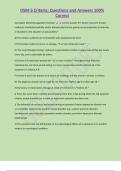DSM -5 Criteria ; Questions a nd Answers 100% Correct Dysruptive Mood Dysregulation Disorder Correct answer -A*) Severe recurrent temper outbursts manifested verbally and/or behaviorally that are grossly out of proportion in intensity or duration to the situation or provocation.* B) The temper outbursts are inconsistent with developmental level. C) The temper outbursts occur, on average, *3 or more times per week.* D) The mood between temper outbursts is persistently irritable or angry most of the day, nearly every day, and is observable by others. E) Criteria A -D have been present for *12 or more months.* Throughout that time, the individual has not had a period lasting 3 or more consecutive months without all of the symptoms in Criteria A -D. F) Criteria A and D are present in at least 2 of 3 settings and are severe in at least 1 of these. G) The diagnosis should not be made for the first time *before age 6 or after age 18.* H) By history or observation, the age at onset of Criteria A -E is *before 10.* I) There has never been a distinct period lasting more than 1 day during which the full symptom criteria, except duration, for a manic or hypomanic episode have been met. J) The behaviors do not occur exclusively during an episode of major depressive disorder and are not better explained by another mental disorder (e.g., autism spectrum disorder, posttraumatic stress disorder, separation anxiety disorder, persistent depress ive disorder [dysthymia]). K) The symptoms are not attributable to the physiological effects of a substance or to another medical or neurological condition. DSM -5 Criteria ; Questions a nd Answers 100% Correct Major Depressive Disorder (MDD) Correct answer -A) *Five (or more)* of the following symptoms have been present during the *same 2 -week period* and represent a change from previous functioning; *at least 1 of the symptoms is either (1) depressed mood or (2) loss of interest or pleasure:* *Symptoms* 1) Depressed mood most of the day, nearly every day, as indicated by either subjective report or observation made by others. 2) Markedly diminished interest or pleasure in all, or almost all, activities most of the day, nearly every day. 3) Significant weight loss when not dieting or weight gain, or decrease or increase in appetite nearly every day. 4) Insomnia or hypersomnia nearly every day. 5) Psychomotor agitation or retardation nearly every day. 6) Fatigue or loss of energy nearly every day. 7) Feelings of worthlessness or excessive or inappropriate guilt nearly every day. 8) Diminished ability to think or concentrate, or indecisiveness, nearly every day. 9) Recurrent thoughts of death, recurrent suicidal ideation without a specific plan, or a suicide attempt or a specific plan for committing suicide. B) The symptoms cause clinically significant distress or impairment in social, occupational, or other important areas of functioning. DSM -5 Criteria ; Questions a nd Answers 100% Correct C) The episode is not attributable to the physiological effects of a substance or to another medical condition. D) The occurrence of the major depressive episode is not better explained by schizoaffective disorder, schizophrenia, schizophreniform disorder, delusional disorder, or other specified and unspecified schizophrenia spectrum and other psychotic disorders. E) There has never been a manic episode or a hypomanic episode. Persistent Depressive Disorder (PDD) Correct answer -A) *Depressed mood* for most of the day, for more days than not, for *at least 2 years.* B) Presence, while depressed, of *two (or more)* of the following: *Symptoms* 1) Poor appetite or overeating. 2)Insomnia or hypersomnia. 3) Low energy or fatigue. 4) Low self -esteem. 5) Poor concentration or difficulty making decisions. 6) Feelings of hopelessness. C) During the 2 -year period of the disturbance, the individual has never been without the symptoms in Criteria A and B for more than 2 months at a time. D) Criteria for a major depressive disorder may be continuously present for 2 years. DSM -5 Criteria ; Questions a nd Answers 100% Correct E) There has never been a manic episode or a hypomanic episode, and criteria have never been met for cyclothymic disorder. F) The disturbance is not better explained by a persistent schizoaffective disorder, schizophrenia, delusional disorder, or other specified or unspecified schizophrenia spectrum and other psychotic disorder. G) The symptoms are not attributable to the physiological effects of a substance (e.g., a drug of abuse, a medication) or another medical condition (e.g. hypothyroidism). H) The symptoms cause clinically significant distress or impairment in social, occupational, or other important areas of functioning. Premenstrual Dysphoric Disorder Correct answer -A) *In the majority of menstrual cycles, at least 5 symptoms must be present in the final week before the onset of menses, start to improve within a few days after the onset of menses, and become minimal or absent in the week postmenses.* B) *One (or more)* of the following symptoms must be present: 1) Marked affective lability. 2) Marked irritability or anger or increased interpersonal conflicts. 3) Marked depressed mood, feelings of hopelessness, or self -deprecating thoughts. 4) Marked anxiety, tension, and/or feelings of being keyed up or on edge. C) *One (or more)* of the following symptoms must additionally be present, to reach a total of 5 symptoms when combined with symptoms from Criterion B above: 1) Decreased interest in usual activities.




